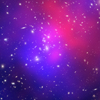CXC Home | Search | Help | Image Use Policy | Latest Images | Privacy | Accessibility | Glossary | Q&A
Tour of Abell 2744
Quicktime MPEG
One of the most complicated and dramatic collisions ever seen between galaxy clusters is captured in this new composite image. This collision site, known officially as Abell 2744, has been dubbed "Pandora's Cluster" because of the wide variety of the different structures found here. Data from NASA's Chandra X-ray Observatory show gas with temperatures of millions of degrees. A map based on data from Hubble and two ground-based optical telescopes reveals the location of matter, most of which is the mysterious material known as dark matter. Working together, these telescopes show that Pandora's cluster is actually the result of the collision of at least four separate galaxy clusters, each coming from a different direction. Scientists think this cosmic smash-up has taken place over a span of some 350 million years.
[Runtime: 01:11]
Quicktime MPEG
One of the most complicated and dramatic collisions ever seen between galaxy clusters is captured in this new composite image. This collision site, known officially as Abell 2744, has been dubbed "Pandora's Cluster" because of the wide variety of the different structures found here. Data from NASA's Chandra X-ray Observatory show gas with temperatures of millions of degrees. A map based on data from Hubble and two ground-based optical telescopes reveals the location of matter, most of which is the mysterious material known as dark matter. Working together, these telescopes show that Pandora's cluster is actually the result of the collision of at least four separate galaxy clusters, each coming from a different direction. Scientists think this cosmic smash-up has taken place over a span of some 350 million years.
[Runtime: 01:11]
(Credit: NASA/CXC/A. Hobart)
Return to Abell 2744 (June 22, 2011)



